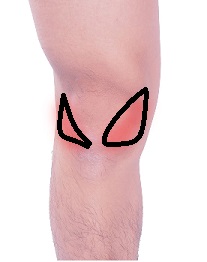What is the PatelloFemoral Pain Syndrome?
Patellofemoral pain syndrome (PFPS) is pain in the front of the knee around the kneecap area, usually causes by the tracking of the kneecap. In most cases of PFPS, the kneecap gets pulled outwards, instead of sitting mostly centered in front of the knee. This causes pulling on the inside of the knee. It could also increase pressure on the outside of the knee joint, as the kneecap is convex sitting in the concave grove of the knee.
Symptoms often includes pain with bending/straightening the knee, stair use, running, squatting, jumping, etc.

Common Causes
- Weakness/decreased control of hip muscles
- Muscle imbalance of the outside muscles of the quads (Vastus lateralis) and the inner part of it (vastus medialis).
- Tightness of the outside part of the quads (vastus lateralis) and ITB
- Bad “posture” during certain physical activity (Running, sports, weight training, etc.)
- Decreased control/range of the foot/ankle
I want to emphasize that you should NOT blame arthritis or “thinned cartilage” for your pain without having a physiotherapist assess it. More often than not, it is not the main cause for this kind of pain. You can usually make a big difference and be pain free, despite the XRAY or MRI findings, as it has been shown by research that medical imaging findings do not always correlate with pain and dysfunction.
Treatment
Physiotherapy is quite effective in treating most PFPS. Treatment is conservative and could usually involve the following techniques.
- Muscle release
- Joint mobilizations
- Dry needling (Watch Video about Dry Needling for this condition)
- Taping
- Strengthening exercises
- Correction of posture of specific activity
Other Conditions Could be Mistaken for PFPS
- Knee plica syndrome
- Referred pain from low back or hip
- Peripheral nerve impingement
- Meniscus sprain/tear
- ACL sprain
- Pez anserinus bursitis/tendinitis
- Patellar tendinitis
Understanding Back Pain
There are many reasons why someone might have back pain. I will be listing below 2 more common scenarios for Low Back Pain and what might be causing them. These 2 presentations of low back issues make up a BIG percentage of low back patients in my physiotherapy practice. If you have back pain, more likely than not, you are in one of these 2 types. Read More…
Stiffness in the Back and Neck in the Morning
Many of us find ourselves waking up in the morning feeling VERY stiff. It sometimes takes quite an effort to roll out of bed and those first few steps might be stiff and sometimes even painful. Why is this happening? Is it the bed or pillow? Could it be age? Is it the way I sleep? Am I developing back or neck problems? Read More…
Is The Pain In My Leg(s) Coming From My Back?
Did you know that one can have pain in any part of the leg(s) referred from the low back, without necessarily having noticeable discomfort in their low back? Read More…
About the Author:
 Lily Zhang is a registered physiotherapist with training specializing in the McKenzie Method. She graduated from McGill University and is currently working in Barrhaven (Ottawa, ON). She has over 10 years of professional training/clinical experience in orthopedic physiotherapy. You can Follow Her Blog @PhysioVive Facebook Page.
Lily Zhang is a registered physiotherapist with training specializing in the McKenzie Method. She graduated from McGill University and is currently working in Barrhaven (Ottawa, ON). She has over 10 years of professional training/clinical experience in orthopedic physiotherapy. You can Follow Her Blog @PhysioVive Facebook Page.

Pingback: Preventing Tendon Injuries - Physiovive
Pingback: IT Band Syndrome: Knee Injury for Athletes - Physiovive
Pingback: Tendon Injury Prevention - Physiovive